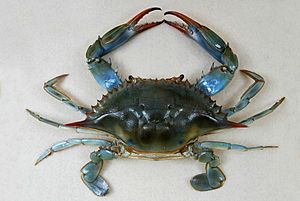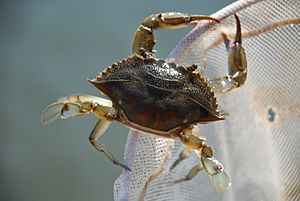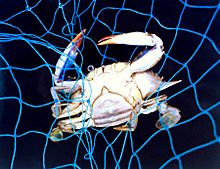Callinectes sapidus facts for kids
Quick facts for kids Callinectes sapidus |
|
|---|---|
 |
|
| Scientific classification | |
| Synonyms | |
|
The blue crab is a type of crab found in the western Atlantic Ocean and the Gulf of Mexico. Its scientific name, Callinectes sapidus, comes from Greek and Latin words meaning "beautiful swimmer" and "savory." This name fits well because blue crabs are known for being good to eat! People also call them the Atlantic blue crab or, in some areas, the Chesapeake blue crab.
Blue crabs are very important for food and business in the USA, especially in places like Louisiana, North Carolina, and the Chesapeake Bay. In Maryland, the blue crab is even the state's official crustacean and a huge part of its fishing industry. However, sometimes there are fewer crabs because of too much fishing or problems in their environment.
Interestingly, blue crabs might actually do well with a warming climate. Warmer waters can help them breed more, survive winters better, and live in more places along the Atlantic coast. Scientists are still studying if this will affect other animals and plants in the ocean.
Contents
What Does a Blue Crab Look Like?
The blue crab is a type of swimming crab. It can grow quite large, with its shell (called a carapace) reaching up to 9 inches (23 cm) wide.
You can easily tell male and female blue crabs apart by looking at their "apron," which is the part tucked under their body.
- Male crabs have a long, skinny apron that looks like the Washington Monument. Their claws are blue with red tips.
- Female crabs have a wider, rounder apron. When they are young, their apron is triangular. When they are grown up, it becomes round, like the dome of the United States Capitol. Female crabs have orange claws with purple tips.
The blue color of the crab comes from special colors in its shell. When you cook a blue crab, these colors break down, and only a red color is left, which is why cooked crabs turn bright orange-red.
Where Do Blue Crabs Live?
Blue crabs naturally live along the western side of the Atlantic Ocean, from Cape Cod down to Argentina. They also live all around the Gulf of Mexico. Recently, they have been seen further north, which might be because of climate change.
Blue crabs have also traveled to other parts of the world, like Japan and Europe. They often get there by hitching a ride in the ballast water of ships. Ballast water is water that ships take in to help them balance. Once in new places, blue crabs sometimes start new fishing industries, like in Greece.
Blue Crab Life
Blue crabs are part of a busy ocean world. They have many animals that hunt them, and they also hunt other creatures.
What Do Blue Crabs Eat?
Blue crabs are omnivores, meaning they eat both plants and animals. They will eat thin-shelled clams, worms, small fish, plants, and almost anything else they can find. This includes dead animals and even other blue crabs!
Who Eats Blue Crabs?
Many animals like to eat blue crabs. These include eels, drum fish, striped bass, trout, some sharks, and rays. Of course, humans are also big predators of blue crabs!
Diseases and Parasites
Like all animals, blue crabs can get sick. They can get diseases from viruses, bacteria, and other tiny organisms. Some of these can make the crabs very ill. For example, a tiny parasite can cause something called "bitter crab disease."
Blue Crab Life Cycle
How Blue Crabs Grow
Blue crab eggs hatch in salty ocean waters. The tiny crab larvae float near the surface and eat small living things. They go through several stages, changing shape each time. Eventually, they become a form called a megalopa, which has small claws. These megalopae then travel towards rivers and estuaries (where rivers meet the sea).
When they reach the brackish water (a mix of fresh and salt water) of the estuary, they change into tiny juvenile crabs that look like adults. Blue crabs grow by shedding their hard outer shell, a process called molting. Underneath, a new, larger shell has already formed. After molting, the new shell is soft and fills with water, making the crab bigger. The shell then hardens.
Blue crabs molt about 25 times in their lives. Males usually molt more times than females. How fast they grow depends on the temperature and how much food they can find. Warmer water and more food mean they grow faster. Crabs in the Gulf of Mexico can grow up in about a year, while those in the Chesapeake Bay might take up to 18 months.
How Blue Crabs Reproduce
Male blue crabs can mate many times. Female blue crabs, however, only mate once in their lives. This happens when they shed their shell for the very last time, which is called their "terminal molt." During this molt, their apron changes from a triangle shape to a round shape.
Mating usually happens in the warmest months. Young female crabs travel to the upper parts of estuaries where adult males live. A male crab will find a female that is ready to molt and guard her for up to seven days. After she molts, they mate. The male then continues to guard her until her new shell hardens.
Female crabs store the male's sperm for up to a year. They use this sperm to lay eggs multiple times in salty water. When it's time to lay eggs, the female carries them in a large mass under her body, which looks like a sponge. She then travels to the mouth of the estuary to release the tiny larvae into the ocean. A female blue crab can produce up to 2 million eggs in one batch!
In the Chesapeake Bay, crabs travel long distances to mate and lay eggs. Females move from less salty areas to very salty areas to release their larvae. In the Gulf of Mexico, spawning (laying eggs) happens throughout the spring, summer, and fall.
Blue Crabs and People
Blue crabs are a very important seafood. People catch them along the Atlantic coast of the United States and in the Gulf of Mexico.
Where Are Blue Crabs Caught?
For a long time, the biggest blue crab fishing area was the Chesapeake Bay. But now, other places are becoming more important. In recent years, most commercial crabs have been caught in Maryland, Virginia, North Carolina, and Louisiana.
For example, in 2013, Louisiana caught a lot of blue crabs, worth about $51 million. Maryland and Virginia also had big catches, worth millions of dollars. Thousands of people in these coastal areas make their living by catching blue crabs.
History of Crabbing
Blue crabs have been an important food source for a very long time. Native Americans and early European settlers in the Chesapeake Bay area ate them hundreds of years ago. At first, crabs were not as popular as fish, and they spoiled quickly, which made it hard to sell them far away.
But in the late 1800s and early 1900s, new ways to keep food cold (like refrigeration) made it possible to send blue crabs all over the country. This made the demand for them much higher.
Early crab fishing was simple. People used nets and traps. The "trotline," a long line with bait, was one of the first big tools for catching crabs for sale. Later, in 1938, the "crab pot" was invented. Crab pots are like wire boxes with funnels that crabs can go into but can't easily get out of. A small section in the middle holds bait, like oily fish, to attract the crabs.
Louisiana and Chesapeake Bay Fisheries
Today, Louisiana has the largest blue crab fishery in the world. They catch more than half of all the blue crabs in the Gulf of Mexico. Many of these crabs are sent to Maryland and sold as "Chesapeake" or "Maryland" crabs.
The Chesapeake Bay has been the biggest blue crab fishing area for over a hundred years. However, the number of blue crabs in the Chesapeake Bay has gone down a lot in recent decades. For example, between the mid-1990s and 2004, the crab population dropped from 900 million to about 300 million. The number of female crabs that can reproduce has also fallen sharply. Scientists believe this decline is due to too much fishing, pollution, and diseases.
Other Animals Caught by Accident (Bycatch)
Sometimes, when people set crab pots to catch blue crabs, other animals get caught by accident. This is called "bycatch." Fish, turtles, and other types of crabs can end up in the pots.
One animal that often gets caught is the diamondback terrapin, a type of turtle. These turtles live in the same areas as blue crabs. Young terrapins can easily swim into crab pots through the funnels. If the traps are not checked often enough, the terrapins can drown. To help prevent this, special devices called "bycatch reduction devices" (BRDs) can be added to the crab pots. These devices make it harder for terrapins to get in, but they don't stop blue crabs from entering.
Managing Crab Fishing
Because blue crabs are so important, people work to manage their populations and make sure there are enough for the future. In 2012, the blue crab fishery in Louisiana was certified as "sustainable." This means they are catching crabs in a way that helps keep the population healthy for a long time. Louisiana is the only blue crab fishery in the world with this special certification.
Images for kids
-
Singer Martha Reeves with a blue crab
See also
 In Spanish: Jaiba para niños
In Spanish: Jaiba para niños







